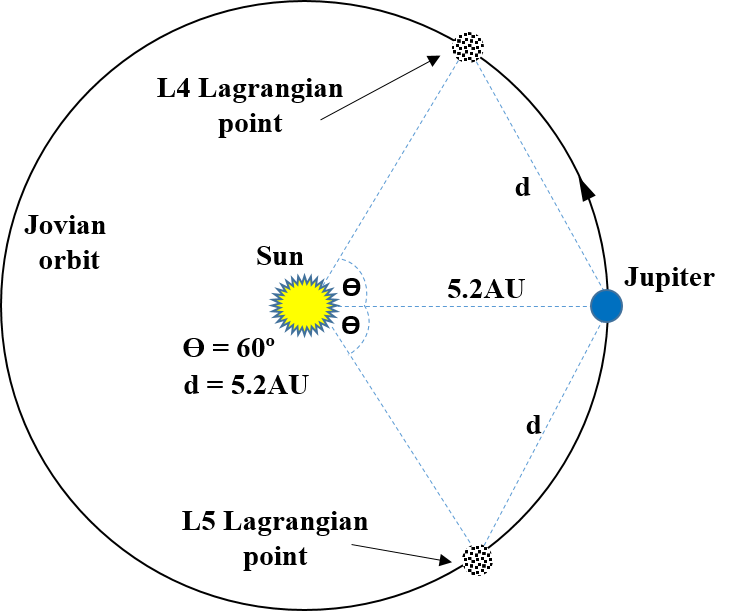Last month we introduced the ‘main-belt’ asteroids. However, although ~94% of all known asteroids are within the main-belt region; many of the more interesting objects are elsewhere. The hazardous NEA (Near-earth asteroids) and the potentially lethal PHA (Potentially hazardous asteroids) are dangers to humanity which we discuss next month. This month however we look at the wonderfully named Trojan asteroids.
Le mois dernier nous avons introduit les astéroïdes de la ceinture principale. Cependant même si 94% de tous les astéroïdes connus se trouvent dans la région de la ceinture principale beaucoup des objets plus intéressants se trouvent ailleurs. Les astéroïdes géocroiseurs et les astéroïdes potentiellement dangereux (APD) posent un risque pour l’humanité: un subjet pour le mois prochain. Mais ce mois nous allons considérer les astéroïdes troyens.
The Trojan asteroids are located at the gravitationally stable ‘Lagrangian points’ of a major planet. The Lagrangian points are locations where the nett forces, exerted by two massive objects acting upon an object of insignificant mass, are balanced and the orbit of any insignificant mass object at such points is in gravitational equilibrium. They are described mathematically by the ‘restricted three-body problem’ first formulated and solved by Leonhard Euler (b.1707 d.1783) and Joseph-Louis Lagrange (b.1736 d.1813). There are five Lagrangian points; three (termed L1, L2 and L3) are collinear (where the three objects are in a line configuration) and are unstable. The two other points, named the L4 and L5 points, form an equilateral triangle shape as shown in our picture below. These points are stable; any small-scale deviations from these points means that the object oscillates about the L4/L5 point.
So for example, in the case of the Jovian Trojans, Jupiter’s orbital period is 11.86 years and its semi-major axis is 5.20AU. The Jovian Trojans vary from 4.62 < a < 5.50 AU in semi-major axis and commensurately 9.94 < P < 12.90 years for orbital period.
The IAU naming convention for Jovian Trojans is interesting. Asteroids at Jupiter’s L4 point are named after figures in Greek mythology and Greek heroes of the Trojan Wars, whilst those at L5 are named after the Trojan heroes.
To date 7294 Jovian Trojans have been identified, 65% of which are at/near L4 and 35% near L5.
The existence and search for non-Jovian Trojans, asteroids which share the orbit of a major planet other than Jupiter, has been considered almost since the discovery of Achilles. To date, Trojan asteroids of Earth, Mars, Uranus and Neptune have been confirmed.
In 1990, 5261 Eureka, preliminary designated 1990 MB was discovered and in 1994 it was confirmed as being an ‘L5’ Martian Trojan. Further Martian Trojans were detected in 1998, 1999, 2007 and 2011; the most recent being 2011 UB256 which brought the total number of Martian Trojans to 9.
Neptunian Trojans have also been found. The first, 2001 QR332 was initially classified as a TNO (Trans-Neptunian object) and so 2005 TN53 took the honour of being recognised as the first discovered Neptunian Trojan – although it was initially classified as a ‘Centaur’. (We will look at Centaurs later). Of the 23 Neptunian Trojans found to date, 20 (87%) are at L4 with 3 (13%) being at L5.
Earth and Uranus each have a single identified Trojan. Earth’s solitary (to date) Trojan was discovered in 2010 (2010 TK7) and is at the Earth orbit L4 position. Uranus has 2011 QF99 at L4, although this may possibly be a Centaur rather than a stable positioned Trojan
No Saturnian Trojans have been found to date, possibly because of Jupiter’s effect. And no Mercurian Trojans have been found.


